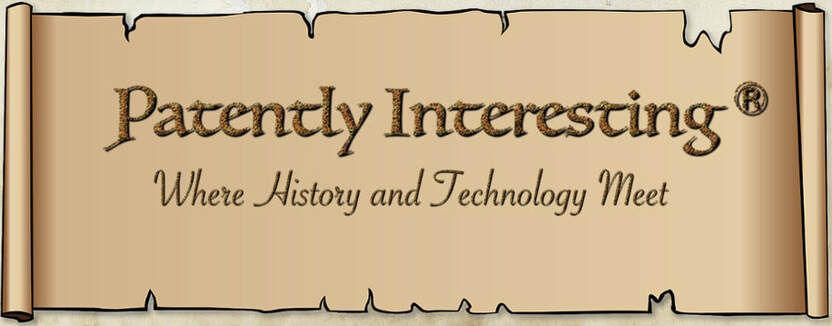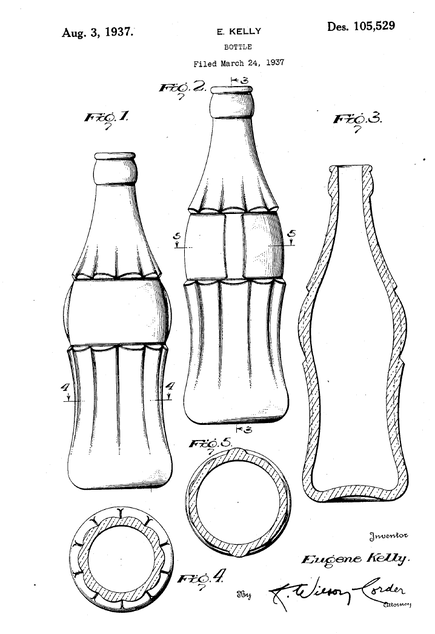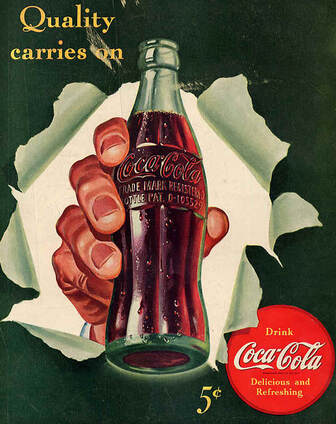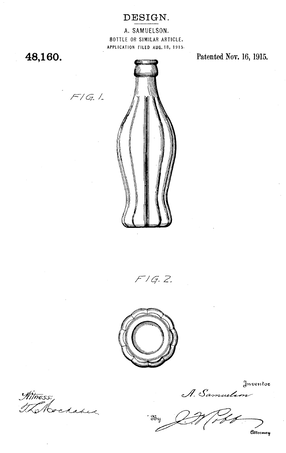 Design Patent No.: 48,160
Design Patent No.: 48,160
On August 3, 1937, U.S. Design Patent No.: 105,529 issued to Eugene Kelly of Toronto Canada for "Design for a Bottle". The '529 design patent would be the third and final design patent in the design progression of the iconic glass Coke® bottle, which began back in 1915. Since that time, the Coke® bottle has become one of the most recognizable packaging forms throughout the world. This recognition is attributable to the unique, contoured shape of the glass Coke® bottle, with its outwardly curving middle section and longitudinal fluting.
The design of the glass Coke® bottle began with a challenge issued by the Trustees of the Coca-Cola Bottling Association in 1915 to a number of U.S. glass companies. The challenge was to to develop a “bottle so distinct that you would recognize if by feel in the dark or lying broken on the ground.” The winner of the challenge was a bottle design by the Root Glass Company of Terre Haute, Indiana that became the subject of U.S. Design Patent No.: 48,160, which issued on November 15, 1915 to Alexander Samuelson, who was the plant superintendent of the company. While he is listed on the patent as being the inventor, it is now generally recognized that Samuelson was not the inventor of the bottle design. That honor goes to Earl R. Dean, who was the bottle designer for the Root Glass Company.
Dean's bottle design sprang from a decision by the Root Glass Company to base the bottle design on one of Coca-Cola soda's two known ingredients, the coca leaf or the kola nut. This led Dean to a library where he saw a picture of a gourd-shaped cocoa pod, which had distinct ribs. It was this picture that inspired Dean to come up with his original bottle design. Unfortunately, Dean's original bottle design never made it into production. The diameter of the middle portion of the bottle was larger than that of the base, which made the bottle unstable on conveyor belts. This instability prompted Dean to modify the design to reduce the diameter of the middle portion of the bottle.
The design of the glass Coke® bottle began with a challenge issued by the Trustees of the Coca-Cola Bottling Association in 1915 to a number of U.S. glass companies. The challenge was to to develop a “bottle so distinct that you would recognize if by feel in the dark or lying broken on the ground.” The winner of the challenge was a bottle design by the Root Glass Company of Terre Haute, Indiana that became the subject of U.S. Design Patent No.: 48,160, which issued on November 15, 1915 to Alexander Samuelson, who was the plant superintendent of the company. While he is listed on the patent as being the inventor, it is now generally recognized that Samuelson was not the inventor of the bottle design. That honor goes to Earl R. Dean, who was the bottle designer for the Root Glass Company.
Dean's bottle design sprang from a decision by the Root Glass Company to base the bottle design on one of Coca-Cola soda's two known ingredients, the coca leaf or the kola nut. This led Dean to a library where he saw a picture of a gourd-shaped cocoa pod, which had distinct ribs. It was this picture that inspired Dean to come up with his original bottle design. Unfortunately, Dean's original bottle design never made it into production. The diameter of the middle portion of the bottle was larger than that of the base, which made the bottle unstable on conveyor belts. This instability prompted Dean to modify the design to reduce the diameter of the middle portion of the bottle.
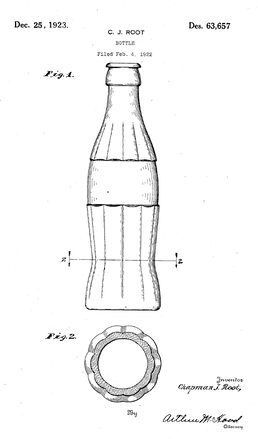 Design Patent No. 63,657
Design Patent No. 63,657
By 1920, Dean's modified design was the standard glass bottle of the Coca-Cola Company. In the early 1920's the design of the bottle was changed and a second patent on the new design issued on December 25, 1923 (U.S. Design Patent No.: 63,657). Since the design patent issued on Christmas, the new bottle was nicknamed the "Christmas bottle". The inventor of the '657 design patent is listed as Chapman J. Root, who was the owner of the Root Glass Company.
The '529 design patent covered the third major design change that was made to the glass Coke® bottle. A bottom portion of the bottle was rounded, and the fluting terminated just above this bottom portion so that the bottle had a circular footprint. A pair of opposing arcuate ribs were also formed in the middle portion of the bottle.
Eugene Kelly, who is listed as the inventor of the '529 design patent, was, at the time of the invention, the managing director of Coca-Cola Canada.
While the '529 design patent has long since expired, the shape of the glass Coke® bottle is still protected from copying, not by patent, but by trademark. A trademark registration (No.: 696,147) for COCA-COLA, together with the design of the bottle, was obtained on April 12, 1960, and a trademark registration (No.: 1,057,884) for the design of the bottle alone was obtained on February 1, 1977. Both trademark registrations are based on the design of the '529 design patent.
The '529 design patent covered the third major design change that was made to the glass Coke® bottle. A bottom portion of the bottle was rounded, and the fluting terminated just above this bottom portion so that the bottle had a circular footprint. A pair of opposing arcuate ribs were also formed in the middle portion of the bottle.
Eugene Kelly, who is listed as the inventor of the '529 design patent, was, at the time of the invention, the managing director of Coca-Cola Canada.
While the '529 design patent has long since expired, the shape of the glass Coke® bottle is still protected from copying, not by patent, but by trademark. A trademark registration (No.: 696,147) for COCA-COLA, together with the design of the bottle, was obtained on April 12, 1960, and a trademark registration (No.: 1,057,884) for the design of the bottle alone was obtained on February 1, 1977. Both trademark registrations are based on the design of the '529 design patent.

